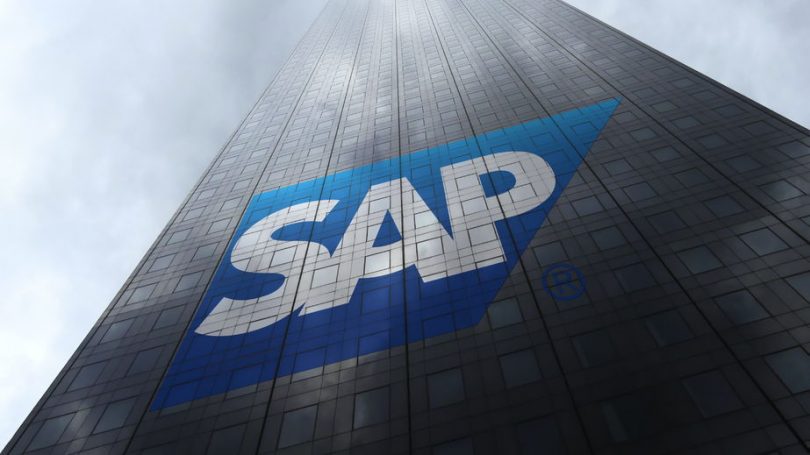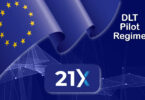Blockchain and distributed ledger technologies at their core are distributed or peer to peer databases. This seems like a potential existential threat to companies like SAP and Oracle. Perhaps not today, but it will be a serious issue in five to ten years.
Raimond Gross, Chief Blockchain Strategist at SAP, spoke to Ledger Insights at the Blockchain Summit in London. One of the questions put to him was rather blunt: “isn’t SAP likely to be disrupted by blockchain?” Usually, people avoid or deflect that sort of question. Not Gross. He even responded “potentially”, but SAP has a plan.
Future vision
Before looking at that plan, it’s worth exploring Gross’ vision of the future in the next ten plus years. After all, SAP is an enterprise software company, so if enterprises are going to evolve SAP will need to as well.
SAP coined the term intelligent enterprise because they envision systems becoming more intelligent and integrated and taking over more of the repetitive tasks. This is a version of the artificial intelligence-driven picture shared by many.
That scenario will mean that business ecosystems need to change. At a technical level, today integrations between companies use APIs which are point to point. Going forward there will be more shared infrastructure like distributed ledger technology (DLT), thus enabling businesses to share data instead of having to integrate with numerous partners.
SAP also envisions a continuing evolution in business models. For example, the relatively new ride-sharing concept, and we’ve seen the start of usage-based insurance. In the future medication might be paid for based on how well it performs.
So given that context, how will blockchain impact SAP?
Why SAP’s not worried
SAP’s been working with blockchain and DLT for three years, and they’ve looked at both the risk of disruption and the potential opportunity for their business. Gross is not worried for two reasons. “One of the reasons is that we’re onto that already, which means we’ll be quite difficult to be blindsided. Which is good, because personally, I would say mission accomplished for my role.”
The second reason is their position in the enterprise space. “There are not too many people out there that understand enterprise businesses the way we do, ” said Gross.
The strategist believes SAP has superb business networks. And combined with industry knowledge, their expertise, and detailed knowledge about existing business processes puts them in a good place.
He gave an example of their pharmaceutical supply chain project. Initially, there was a prototype involving Merck, AmerisourceBergen, and SAP. After this, a client emailed saying they like the idea, but what about scaling it up? “SAP you have the contacts”. The person at SAP who received the email has worked in client engagements in that sector for 15-20 years. He was able to respond within 30 minutes and just a week later they had an onsite workshop of 20 people including several clients.
What about revenue?
The big question is how do these strengths translate to a future revenue stream for SAP? And are there plans to compete with Hyplerledger Fabric, R3, Quorum and others?
The response was a definitive no. With a caveat ‘as of today’. “We believe it doesn’t make sense to try to out-compete the open source community,” said Gross. Open source is part of SAP’s strategy. They may contribute to the open source blockchain protocols, but they don’t see a role for proprietary software at the blockchain protocol level.
A common metaphor is to compare blockchain protocols to Apple’s IOS or Google’s Android operating system. And in each of those cases, there’s an active ‘app’ ecosystem sitting on top.
So if SAP isn’t planning revenue at the blockchain protocol level, as Gross confirmed that leaves the application layer, which makes a lot of sense. SAP can leverage their existing industry knowledge and expertise to produce shared applications.
The pharmaceutical supply chain project is a good example. For the pharma project, they’re deliberately only addressing one facet in the first phase to get tangible results sooner. The aspect they’re targeting is to verify that returned products aren’t counterfeit before being resold.
Competitive advantage
Gross gave some examples of how their industry knowledge can help with applications. “It’s about the complexity of moving equipment, trucks, ships and everything in a coordinated way. And there’s a lot you have to understand. There’s one way to track a limited supply of high-value objects, diamonds as an example, that’s one case.”
“But on the other hand the largest container ships these days have room for 18000 + containers, and you have 50 palettes and 50 boxes on a palette in those containers, you end up with 45 million references. That’s enterprise dimensions or scale of doing things. And even being aware of this is the magnitude we’re talking about, this is why I believe there are not too many companies around understanding that space.”
The point is that 45 million is a scale that does not work well on some of today’s blockchains. (That said, Zhong An insurance reportedly writes all policies onto a blockchain, and so far that’s more than seven billion.)
It’s hard not to notice that IBM has a blockchain diamond project and also a joint venture with Maersk for container logistics. The latter is a hugely ambitious project though currently, the plan is only to log data at the container level. And IBM is also a company with a track record of reinventing itself in the face of technology shifts.
Several companies are chasing the same target. Chatting to staffers from Oracle at the Blockchain Summit, it seems Oracle has a similar strategy.
It’s a just a matter of time before one of them rebrands to an ‘inter-enterprise software company’.







